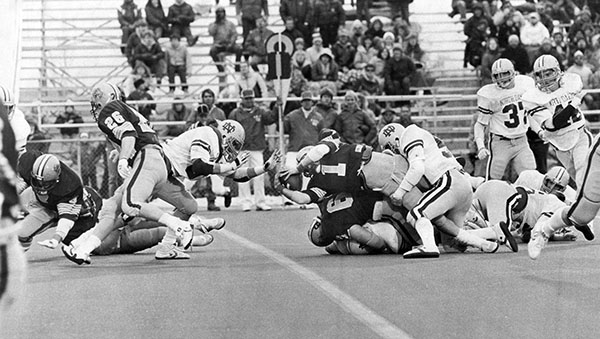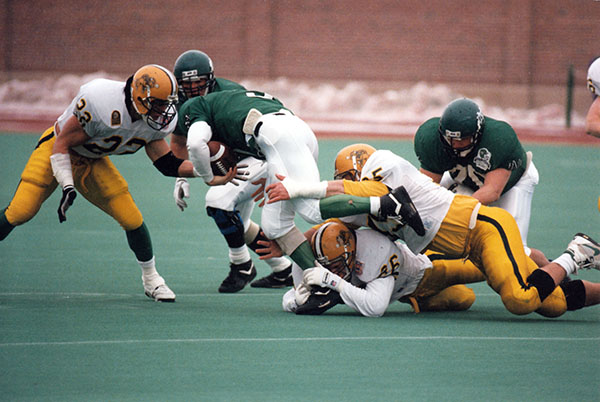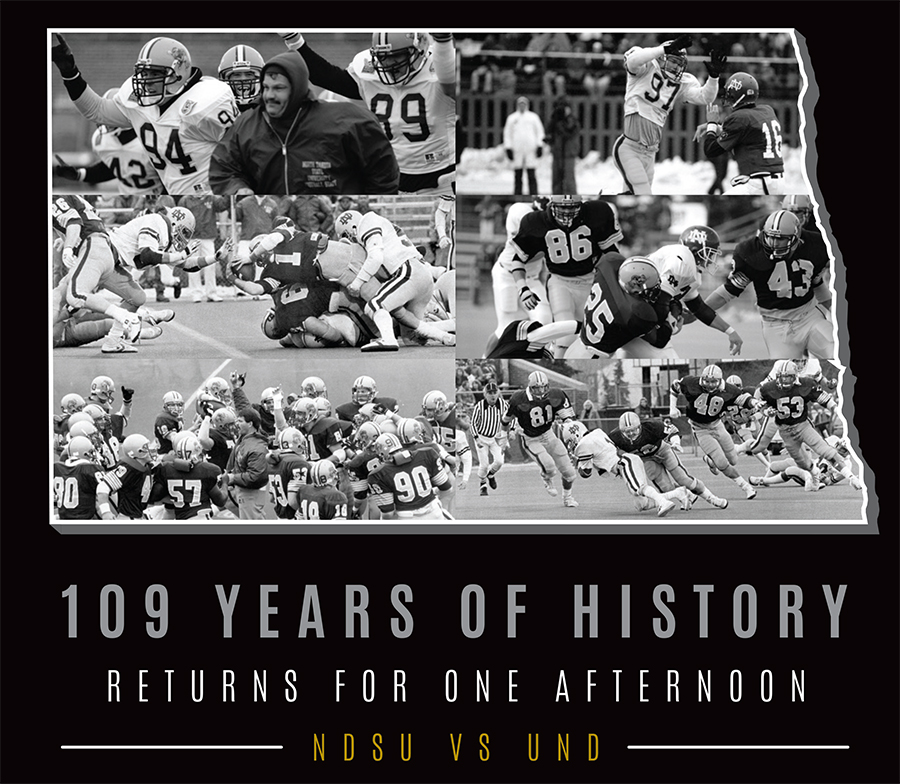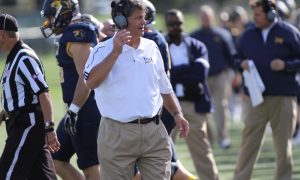Photos Courtesy of NDSU and UND Athletics
(Part II: Anatomy of the NDSU-UND Rivalry)
How do you liven up a 121-year-old football rivalry? Put it on a 12-year hiatus, introduce two new generations of athletes and fans and play it on the Division I level. Through the next six chapters, we break down the NDSU-UND football rivalry starting in the 1980s all the way through the process of both programs appearing back on each other’s schedules.
Chapter 1: NDSU Domination
To be fair, picking up the NDSU- UND football rivalry after the first 78 games were played in the series seems a bit unfair. And it could be. But when you take into account how high the stakes were when approaching the 1980s, combined with the quality of broadcasting showing the famous bouts on the football field, it only makes sense to dissect the rivalry after the 1980 game when UND beat NDSU 38-20 in Grand Forks. It should be noted that the rivalry game was big even back in 1965 when NDSU won its first Pecan Bowl.
According to NDSU’s attendance records, that season NDSU hosted the Fighting Sioux – as they were once called – 11,500 people were in attendance. 1965 was the first time in recorded history the rivalry would be seen by more than 10,000 people. And since 1970, only twice were there fewer than 10,000 North Dakotans in the seats to watch its state’s two perennial college football powers battle it out for bragging rights from Fargo to Grand Forks to Beach to Williston. The two times when attendance stayed under five digits was in Grand Forks when both games were stricken by blood-chilling cold weather and NDSU domination.
Alas, to recap the first 78 games in the historic NDSU-UND football rivalry: NDSU won three championships while UND had none. NDSU had 15 North Central Conference championships while UND claimed 16. To go along with capturing one more conference title than the Bison, UND had a 22 game lead in the series, 52-30-3.
Nobody epitomized knowing your opponent more than NDSU and UND. They were both among the nine institutions that were charter members of the now-defunct North Central Conference. The two were also among the five that remained with the conference into the 2000s.
Before the 1981 season, Don Morton, and the Bison had lost two straight games to UND and were losing momentum in the state. Since the inception of the Division II playoffs, NDSU had played four postseason games compared to UND’s two, but UND had made the playoffs more recently in 1979. The pressure was on Morton to live up to the high expectations set by his predecessors Darrell Mudra, Ron Erhardt and Jim Wacker.
“It was made very clear to me before the game that if we had lost, I was done,” Morton said. “No coach could survive losing three games in a row to UND. The athletic director was a very good friend of mine (Ade Sponberg), but it was very clear that this was what you’d call a ‘must-win’ game.”

Quarterback Mark Nellermoe led the Bison with three second-half touchdowns and the Bison prevailed against the No. 1-ranked Fighting Sioux, 31-7. It would be the beginning of the longest winning streak the Bison would experience against UND. For the next decade, the Bison would leave the field victorious against their in-state rival and so began a new era of Bison football.
“For us it was Sioux week, for them it was Bison week. It was just a very special week of preparation,” said Morton. “At the time, whenever we had the home game, whenever we hosted the Sioux, our Team Maker membership would do really well that year because everybody wanted to make sure they had tickets to the game.”
Interest was mounting as the Bison would win five championships over their 12-game winning streak against UND. Today, we recall the stretch as “The Decade of the Bison,” and it seemed UND was getting worse and worse with a record of 32-32, spanning from 1981-86. But the fans couldn’t get enough.
“It was just a big event,” explained Morton. “It was a big event in North Dakota, in the state and in the region.”
Former WDAZ sports director Pat Sweeney immersed himself in the rivalry when he started covering UND sports in 1982. For the first 11 years, he thought he’d never see UND defeat its rival.
“I remember I was there in Fargo in ’85, the 49-0 game, and I was doing sideline (reporting) and I just remember thinking, ‘What’s going to happen?’ And the next day Pat Behrns (UND head coach) resigned as the coach,” Sweeney said. “I got along great with Pat and I think he did the right thing. For him to continue would’ve been difficult. I don’t know if the AD had in mind to make a change. He may well have.”
The 1985 game was the biggest shutout in the rivalry’s 91-year history, and just when UND thought it couldn’t get any worse, Jeff Bentrim and the potent Bison veer attack came to Grand Forks for one last time in 1986. Bentrim had one of his best games as a Bison, scoring three touchdowns and shattering Walter Payton’s Division II career touchdown record (64) as the Bison rolled 63-10.
It was a difficult introduction to the rivalry for first-year UND head coach Roger Thomas, but it’s one he’ll never forget.
“It was hard,” Thomas said. “Just because the team was at that point mismatched… I don’t want to throw anybody under the bus, but the Bison teams continued to get better, and the era between that and the late ‘80s when UND wasn’t as powerful.”
As the Bison enjoyed success against their in-state rival and at the highest level of Division II competition, Thomas knew he’d have to employ a new culture and, more importantly, the same culture he was a part of while he was an assistant at UND from 1978-79.

Chapter 2: Return of the Sioux
It’s not out of the ordinary to hear Roger Thomas’s name spoken around Bison Nation in the same sentence as an expletive and a facial expression signifying disgust. He was the leader, the mystique and the catalyst behind the UND football revival starting in the late ’80s.
To this day, Thomas gets nasty looks while he’s in Fargo. He told the story about him and his wife coming to Fargo to wander around the mall when all of a sudden Thomas’s eyes caught the face of a Bison fan wearing a national championship jacket.
“I walked by him and he kind of grumbled at me, and kind of gave me a dirty look,” Thomas said trying not to laugh. “I was like, ‘C’mon, man.’ But it lives. It was fun to be the enemy because they were so good, and I still respect them, and it was fun to be the enemy and to take the UND program, which was kind of down and out at the time, and get it back.”
Educated in the North Central Conference at Augustana, Thomas shared the sidelines with Bison legends Don Morton and Jim Wacker early in his career at his alma mater, but as his career path started to take shape, their success would become the goal chased by Thomas when he took over the reins at UND in 1986.
“The games in that era, in the late ‘80s, were pretty tough because the Bison were loaded with the (Tony) Satters and everybody else,” Thomas said. “We really needed to recruit some kids to try and play at that level, which was the top level in the country. Heck, they were very, very good.”
Thomas knew he needed to raise the talent level at UND to compete with the unstoppable machine that was the Bison veer offense. NDSU had the horses, starting with Jeff Bentrim and Chris Simdorn, and then later it turned into Arden Beachy, Rob Hyland and Kevin Feeney. Thomas turned to his defense, knowing they were the key to containing the Bison ground-and-pound assault.
In 1988, Thomas hired former UND running back and ‘85 graduate Dale Lennon to coach the defensive line. Lennon had roots in North Dakota. He understood North Dakota football and had been a freshman on the 1979 team, the last UND team to make the playoffs.
“Our challenge was two things,” Thomas explained. “We needed to have a scheme that gave us a chance to defend the option and the other thing was better players.”
Thomas gives credit to coach Lennon and Bubba Schweigert for recognizing UND’s weakness in the interior line. “We always had trouble finding them,” Thomas said when explaining the reasons UND switched to a 3-4 formation on defense, which has three linemen and four linebackers.
With four athletic linebackers running behind the line away from the trenches, the more plays they were free to make. This also changed their practice philosophy, Thomas said. With the quick striking offenses beating UND to the edge with more speed, they worked tirelessly on pursuit drills, which helped instill simple geometry into defenders and helped them take the quickest angle to a ball carrier.
“We had to get our football team to go run down those good athletes, to take good angles to go catch that guy and use the sidelines as your friend if the play went wide,” Thomas said. “It was really an evolution of football defense, regardless of the 4-3 or the 3-4.”

UND was getting better and their record was starting to prove it. They would finish over .500 in 1991 and 1992, and in 1993, they qualified for the playoffs for the first time in 14 years. But more importantly, earlier that season, the night before Halloween at Memorial Stadium, they proved they belonged on the same field as NDSU.
Following a seven-point loss in 1991 and a one-point loss in 1992, UND was at the doorstep, on the fringe of snapping their 12-year losing streak to NDSU.
“The games were getting closer and that was a good sign,” remembered WDAZ’s Pat Sweeney. “But there was still, to me, there was still that cloud hanging overhead. Until they beat them that was never going to go away.”
Sweeney happened to be calling the NDSU-UND game on statewide television with Ed Schultz in 1993. UND fans remember it as the Mike Mooney game. One play, from one of Lennon’s athletic linebackers who was told he was too small to play at NDSU, changed the course of history in not only the NDSU-UND rivalry, but changed the course of UND football history forever.
There’s still mystery surrounding the play, said Sweeney, who then admitted none of the four cameras they had on the field picked up exactly what happened when Mooney went into the pile to bring down NDSU running back Jason Miller. Sweeney said he’ll never forget Mooney streaking down the sideline to give UND a lead late in the fourth quarter.
“I still say that Mike Mooney strip and return for a touchdown was the most important play in modern UND football history because it was so surprising and it just changed everything that led to the victory, and UND was no longer a bridesmaid,” Sweeney said.
“It was a stolen ball that I still believe wasn’t the right call,” chuckled former NDSU head football coach Rocky Hager, who believed Miller’s forward progress had been stopped before Mooney’s infamous strip-and-score. “I just don’t think he (the official) made the right judgment.”
As NDSU loathed in its first defeat to UND since 1980, on the other side of the field, jubilation stormed the field. The monkey was off UND’s back. After two years of coming up short, they finally defeated their in-state rival, reclaiming the Nickel Trophy and changing the trajectory of the program with a 22-21 victory.
“There are so many stories that go along with that game and what went on in Grand Forks that night is just crazy,” Thomas said about the postgame celebration after his first win over NDSU. “Dave Gunther, the old basketball coach, told me, and he was a great friend. He said, ‘Roger, that’s great you won, but you’re nothing until you beat them in Fargo.’”
In their first game in the FargoDome the following year, UND defeated NDSU in front of a crowd of 18,760, many of who were leaving by the time the fourth quarter rolled around, according to Sweeney. Thomas would never lose a game in the FargoDome. He was 3-0.
Thomas left coaching after the 1998 season to become UND’s athletic director and he handed the keys to the still up-and-coming football program to the defensive genius of Lennon. The Knox, N.D., native would bring UND its first national championship in 2001 and posted a 4-1 record against the Bison, including the last matchup between the rivals in 2003 with a 28-21 overtime victory.

Chapter 3: Growing Up In The Rivalry
As Dale Lennon put it: “It was a game that defined ya. Everything, all the work you put in, it motivated ya; it inspired ya. It made you better.”
If anything proves that rivalries aren’t spawned out of thin air, it’s Lennon’s quote about the importance of this one game. Back then, the rivalry wasn’t tangible; it wasn’t conceived from online message boards or Twitter. It wasn’t bought or sold. It was inherited from one generation of football players to the next. The anticipation of the rivalry game was built over time, culminating in one large explosion once every year and then pondered and rehashed for the next 364 days.
It becomes a part of life for more than the players. Everybody in the region with ties to either university owned it. And it was their duty to pass it along to the next generation wearing either shade of green, Castleton or Kelly.
For Lennon and fans, the NDSU-UND football rivalry is a personal one. It becomes more than a silly game when it never lets you down. You know every fall there will be a matchup where you can put the past games aside, put your personal and professional life on the back burner and enjoy your state’s Super Bowl played out on the college gridiron.
Rocky Hager grew up in Harvey, N.D., a town of 1,700 that’s about a three-hour drive from both Fargo and Grand Forks. He was born into farm life, tending to his livestock’s needs and always having a fascination with football. When he was in junior high, his aunt started dating a men’s basketball player from NDSU and from then on, Hager knew where his allegiance stood when it came to the biggest football game played in the state.
“I learned about the intensity of the rivalry,” Hager said. “I learned the ‘Hail the Bison’ song before I was in high school. I had strong knowledge of it and we raised horses so there was a strong affiliation with the animal sciences at NDSU. It was a place I would’ve liked to work at when I was very young.”
The NDSU-UND football game was one that Hager would always look forward to watching or listening to every season. And he said he was always disappointed when his responsibilities with the horses took precedence the weekend of the NDSU and UND game.
Hager would eventually play football at Minot State for four years in the mid- 70s, but when his favorite school came knocking when he was looking for his first coaching job, he wasn’t going to miss it. He spent a year on the NDSU staff as a graduate assistant.
Hager’s first job with NDSU was in 1979, ironically, it was also the first time he and Roger Thomas were on opposing sidelines during an NDSU-UND football game.
The relationship between these two legendary coaches is something the media skewed as passionate hate, but it was more civil than what fans were led to believe.
“I connected with him through the Augustana connection,” Hager said. “I would label Roger as a friend.”
Thomas played running back and quarterback for Augustana in the 1960s and then coached his alma mater until 1976. Hager arrived later in 1981 and left after the 1984 season to become the defensive coordinator at NDSU.
“I’m not close friends with him by any stretch,” Thomas said. “But we did talk every so often, especially after that (rivalry) week. We might give each other a call … Some of it was social and just chatting, kind of laughing at the crazy things that are said about the rivalry and stuff.”
Hager said the last time they spoke was when he called Thomas to congratulate him on his induction into the University of North Dakota Hall of Fame last year.
One player that helped springboard Thomas to the Hall of Fame was tight end Jim Kleinsasser.
The Kleinsasser family had already sent one kid to UND to play on the women’s basketball team, which at the time was building its own rivalry with the NDSU in the 1990s. Sheri (Kleinsasser) Stockmoe was a post player for Gene Roebuck from 1991-1995.
Although Kleinsasser said that where his sister played ultimately didn’t factor into his decision to play at UND, he knew everything about the rivalry. His small hometown of Carrington, N.D., would have the rivalry game on television every year, and he said everybody would get together to watch the games.
Kleinsasser decided to play at UND because he felt his talent would translate more on the offensive side of the ball. He said NDSU wanted him to play defense so he made the choice to follow in his sister’s footsteps and the rest was history.
It was an unfortunate miss for the Bison.
He played for UND from 1995-1998 and was named first team All-North Central Conference three times. The Kleinsasser light seemed to shine the brightest when he’d play NDSU. Painfully, Bison fans remember UND making the trip to the FargoDome in 1998. UND rolled to victory 39-25 with Kleinsasser catching eight passes for 169 yards, three touchdowns and caused thousands of headaches in the NDSU home crowd.
“Every once in a while people will pull up that clip and say, ‘What? You used to be able to run this fast?’” Kleinsasser chuckled. “Well, yeah, a few moons ago I could. That was a fun game at that time, too.”
Kleinsasser would be drafted 44th overall in the 1999 NFL Draft by the Minnesota Vikings, and he would spend 13 seasons in Minneapolis.
The quasi-face of UND wasn’t the only star from the rivalry to find decade-long success in the NFL. NDSU’s Phil Hansen didn’t get his first introduction to the rivalry until his freshman season in 1986. It quickly dawned on the Oakes native that it was a bigger deal than he initially thought when he was growing up a little more than 100 miles from Fargo.
“We probably downplayed it to the media, saying this game this week is always the most important, but it’s always in the back of your mind,” Hansen said. “We were kind of prepped and taught that you don’t want to live with having lost to the Sioux, and that’s the mentality we were ingrained with as a freshman.”
The engraving by the upperclassmen stuck with Hansen’s class that included legendary quarterback Chris Simdorn and running back Tony Satter. Not only would that Bison class win three national championships, but it never lost a game to UND. And it wasn’t just another win, they were blowouts. From 1986 to 1990, the Bison outscored UND 201-64, including a shutout in 1989.
The tough times would eventually get better for Thomas’s UND teams. Both Thomas and Lennon were able to hold onto the thin layer of hope and managed to hype every NDSU-UND matchup to keep the rivalry tradition fueled with passion.










